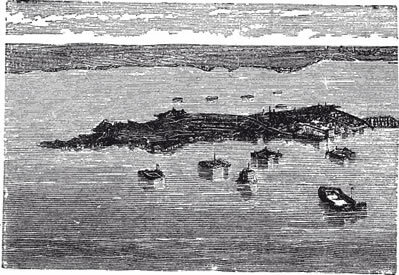One of the facts that generated great divergence about the paths taken by the Russian Revolution was the crushing of the commune of Kronstadt, in 1921. Named by its supporters as the third Russian Revolution, and by its detractors as the last army-led revolt White, what was certain was that the end of the revolt also marked the beginning of the complete domination of society by the Bolshevik Party. Soviet.

The fortress of Kronstadt in 19th century engraving. According to Trotsky, the place was the “pride and glory of the revolution”
Kronstadt was a naval fortress located on an island in the Gulf of Finland near the city of St. Petersburg. Traditional support base for Russian navy fleets in the Baltic Sea and main protection of the city of São Petersburg, the Kronstadt fortress and the sailors who worked there were considered the “pride and glory of the revolution".
This fame was won by pioneering actions in the 1905 and 1917 revolutions. The participation of sailors from Kronstadt in the 1905 revolution it was immortalized in Sergei Eisenstein's famous film, The Battleship Potenkim. And even in February 1917, it was the sailors of
Kronstadt the first to declare the creation of a soviet, responsible for organizing the workers and an organ of opposition to the capitalist state that was being constituted with the provisional governments.During the Civil War of 1918-1920, the naval fortress stood out for its role in defending the revolution against army forces. White, one of the reasons why Trotsky, leader of the Red Army at the time, uttered the phrase indicated above, the “pride and glory of revolution". Because of the ironies of history, it was also Trotsky who led the Red Army troops who massacred the Kronstadt rebels in March 1921.
Defenders point to the revolt of Kronstadt as the third Russian Revolution, arguing that it revived the principles of workers' democracy inaugurated after February 1917 and lost during war communism. After supporting the workers' strike in St. Petersburg, held after the end of the Civil War against the precarious living situation, the sailors of the ships Sevastopol and Petropavlovsk became they sympathized with the strikers and approved a 15-point manifesto calling for, among other things, free elections for the soviets, freedom of the press and organization for the workers. They intended, thus, to contain the Bolshevik domination built during the Civil War, since the power of the threat of the white army had been almost exterminated.
Do not stop now... There's more after the advertising ;)
But this was not the way of looking at the facts of the Bolshevik party leaders. For them, the revolt was a reaction of what was left of the White army forces, the revolt being led by a former tsarist general. Furthermore, the Bolsheviks argued that the participants were members of parties which were outside the representation of the Soviets, such as the Revolutionary Socialists and the Mensheviks. Another reason for defeating the insurgents was that they defended petty-bourgeois positions, peasants and artisans, which weighed against the achievements of the proletarian revolution of October 1917.
With this divergence on the directions to be given to the revolution, the rebels of Kronstadt and the Red army fought for 10 days, between March 7 and 17, 1921, over the frozen waters around the fortress. Estimates indicate that thousands of fighters died until the Red Army conquered the fortress on March 17th. It is interesting to note that between March 8 and 16, 1921, the X Congress of the Bolshevik Party was being held in Moscow, where the political tendencies of opposition to the party leadership, represented in the figures of Lenin, Trotsky and Stalin, were also defeated. principally.
The trends were defeated for advocating the return of free soviets and trade unions, as well as press freedoms, once the civil war had ended. Points very similar to those of the naval fortress rebels. Internally defeated, many oppositionists set out to aid the repression of the Kronstadt, highlighting one of the many contradictions of the Russian Revolution.
By Tales PINto
Graduated in History
Would you like to reference this text in a school or academic work? Look:
PINTO, Tales dos Santos. "Kronstadt and the Third Russian Revolution"; Brazil School. Available in: https://brasilescola.uol.com.br/historiag/kronstadt-terceira-revolucao-russa.htm. Accessed on June 28, 2021.
